Recently, the Mechanical Hub team took part in a two-phase, two-state trip to visit Viega’s North American manufacturing in McPherson, Kansas, and toured the brand new HQ and Seminar Center in Broomfield, Colo. Impressive is the first thing that comes to mind when describing both facilities. The McPherson manufacturing facility exudes the company’s philosophy of Read more
Viega


The new Viega North American headquarters in Broomfield, Colo., was designed to look like a fitting.
Recently, the Mechanical Hub team took part in a two-phase, two-state trip to visit Viega’s North American manufacturing in McPherson, Kansas, and toured the brand new HQ and Seminar Center in Broomfield, Colo. Impressive is the first thing that comes to mind when describing both facilities.
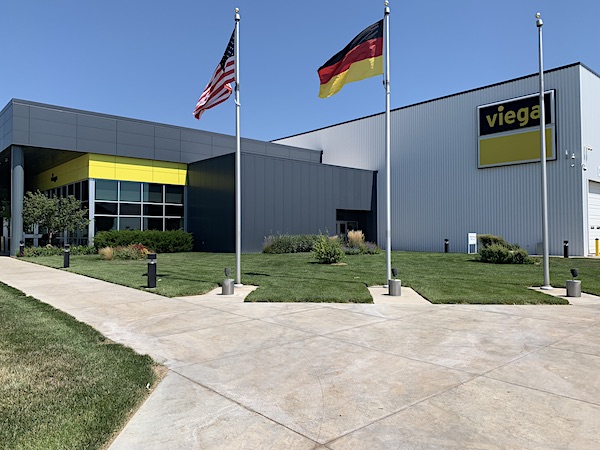
One of the Viega manufacturing facilities in McPherson, Kansas.
The McPherson manufacturing facility exudes the company’s philosophy of both progress and vision for the future. “We are constantly looking past the immediate future and into the distant future,” Eric Wicker, director, manufacturing, Viega.

Eric Wicker, director, manufacturing, Viega
This summer, Viega completed a two-year building program in McPherson that included: a 90,000-sq. ft. expansion of a manufacturing plant, completed in Dec. 2017; a new 205,000-sq.-ft. manufacturing plant, completed in June; and a new 25,000-sq.-ft. tool shop and apprentice building, completed in July. And, the company is currently building a 55,000-sq.-ft. logistics expansion—a high-bay storage and retrieval area for inventory.
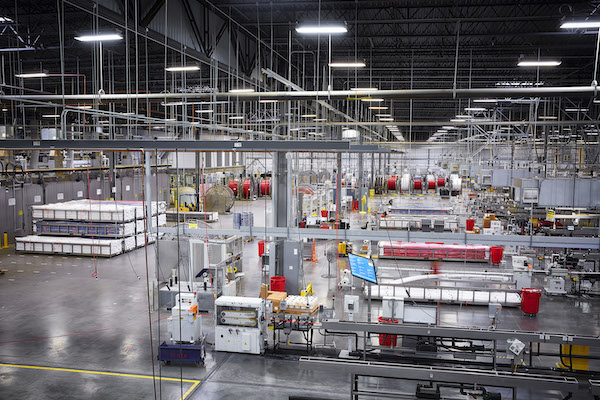
The manufacturing floor at the McPherson facility is as meticulous as it gets.
Mimicking some of the processes from its global HQ in Germany, robotics and machining take center stage throughout the meticulous McPherson plant. Fear not, all of this new-fangled technology is not taking jobs away, rather increasing them. Currently at approximately 300 employees, the company hopes to hit the 500 mark by years ’23-’24.
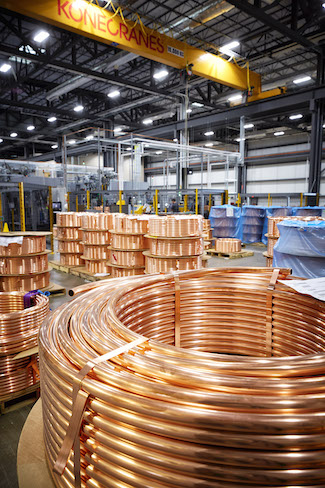
Some of the copper inventory, now produced in the states.
McPherson is where Viega produces its PureFlow line of PEX product, as well as select fittings from the ProPress Copper and 80,000 sq. ft. dedicated to its MegaPress product lines. McPherson is also home to Viega’s master distribution center for North America.
Continued expansion is a testament to the company’s progressive philosophy. For instance, the company has dedicated 270,000 sq. ft. to the copper fitting production. “The goal is to be producing the majority of copper fittings sold in the U.S. right here in the states,” says Wicker.
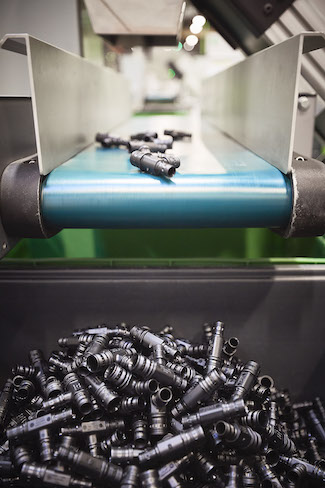
Plastic fittings rolling off the line. Seven million per month made in Kansas.
The state-of-the-art distribution center incorporates the latest technology and automation, as well as an upgraded warehouse management system that provides faster product turnaround. With additional metals products being manufactured in McPherson, a larger distribution center for both metals and PEX products was necessary.
Although media wasn’t allowed to shoot photography inside the plants—understandably—the tour started in the 36,000-sq.-ft. Plastic Injection Molding area which exemplified the company’s high investment in tooling. Twenty machines produce approximately seven million fittings per month. This particular building was well lit and comfortable, due, in part, by the implementation of its own radiant heating and cooling technology.
Quality is never understated at Viega; we strolled through the Quality Assurance Lab where dedicated staff monitor product and equipment through a series of rigorous testing.
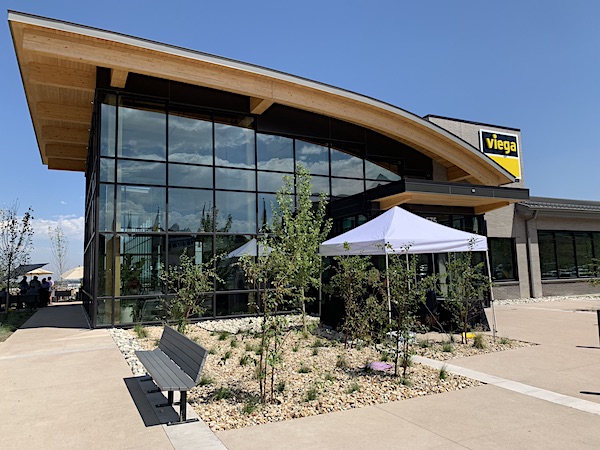
The Broomfield Seminar Center
Next, we toured the 200,000-sq.-ft. Extrusion Area where the plastic piping is made. Once made and exported from Georgia, Viega now produces its own resin—which is transformed into pellets—onsite. The rejected pellets are not repurposed, yet recycled and sold.
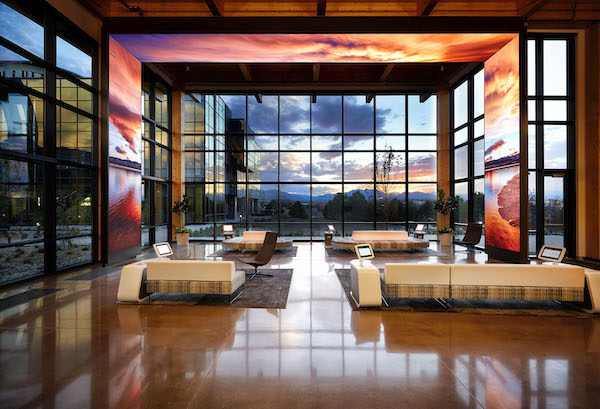
Whoa! Check out the beautiful seminar center, and the frickin’ view!
There is a Special Extrusion Area where plastic metal plastic tubing extrusion is performed. The only company in America making this, the plastic piping is integrated with aluminum so it can better hold its shape rather than returning back to its original form. (Nearby is a 40,000-sq.-ft. dedicated machine shop.)
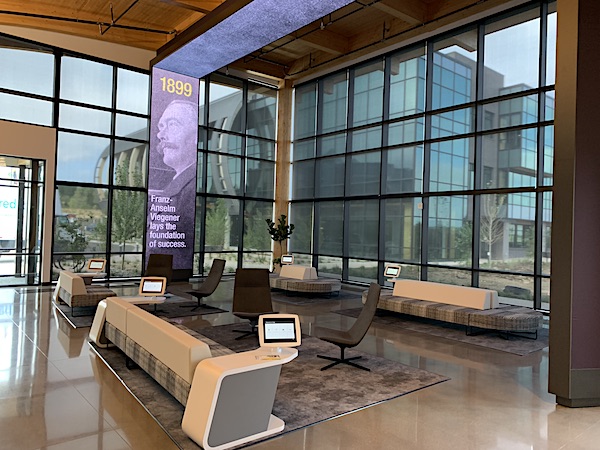
Another angle of the entrance to the seminar center with the HQ in the background.
We then toured the 270,000 sq. ft. of ProPress copper fittings production area and 80,000 sq. ft. of the MegaPress/Metals production area. Strategically, it makes sense for Viega to start producing here in the states. With press technology introduced here in 1999, education and awareness of the process and technology have helped contractors nationwide run a more efficient business. Viega system solutions are designed to work together in plumbing, heating, cooling and pipe joining applications, making the contractor’s work fast, easy and safe.
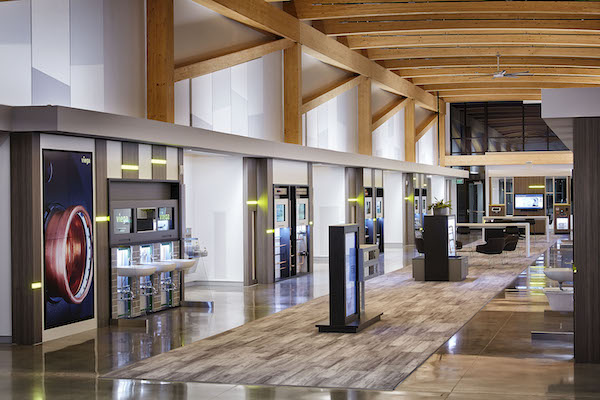
The seminar center features an interactive display area chock full of Viega products.
The following day we were flown to Denver to tour the recently opened Viega North American headquarters and Seminar Center in Broomfield, Colo. The 55,000-sq.-ft. headquarters resembles a pipe fitting, and its interior is the real testament to Viega innovation. I can’t express enough how beautiful these two buildings are, and, of course, amid the breathtaking backdrop of the Rocky Mountains. The HQ building opened in January and the first official training took place April 8, and weekly training is booking fast. “Viega is absolutely committed to its customers and their success in the field,” says Bo DeAngelo, manager, technical training at the center.

Like a proud new papa, Bo DeAngelo gives the tour of the new seminar center.
Yet, I am always interested: when a new facility is built, does it incorporate its own products? While the cross-laminated timber beams are imported from Austria, the exposed ceilings give employees and visitors a clear view of the many uses of Viega’s innovative technology.
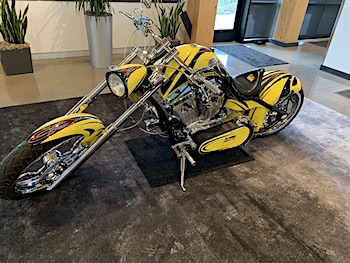
We’ve located the custom Viega chopper! It was taken in the middle of the night from the McPherson facility and relocated to Broomfield where it sits proudly on display. Who has the keys?
Potable water is carried through copper pipes connected with ProPress fittings. The carbon steel fire sprinkler system is joined with MegaPress fittings. Radiant heating and cooling keeps the building comfortable, while a snowmelt system keeps the courtyard free of ice and snow. Manifolds ensure the systems operate smoothly and efficiently. The restrooms feature wall-hung bowls and no exposed tanks, thanks to in-wall carrier systems and Visign style flush plates.
The new 23,000-sq.-ft. Broomfield Seminar Center next door supplements Viega’s Nashua, New Hampshire Seminar Center, which has trained thousands of people since opening in 2006. The new center is an innovative training experience and is equipped with four classrooms, two hands-on labs, and interactive displays throughout, which allows attendees to see, touch and experience Viega products. “Demand for training has been increasing steadily. This facility will allow us to continue to provide and expand on the training that our industry deserves,” says CEO Dave Garlow.
Viega experts lead single- and multi-day classes in everything from radiant system design and fire protection to hydronics and pathogen prevention. Despite being open only since April, it is on track to host more than 2,100 students this year, says DeAngelo.
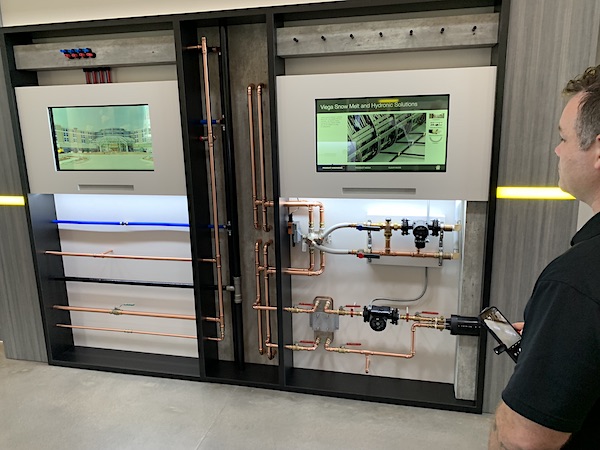
The Hub’s Eric Aune checks out the hydronics and snowmelt display.
I walked away very impressed, telling DeAngelo I—and I’m sure the clients that visit—can’t help but feel energized the minute I walk in this facility. Shaking his head in agreement, “That’s what Dave Garlow tells me every day he walks in here,” responded DeAngelo.
Make no mistake, there is a lot of money, time and resources invested in Viega North America. But it’s a huge testament to the dedication the company believes is its biggest investment: its customers and its employees.
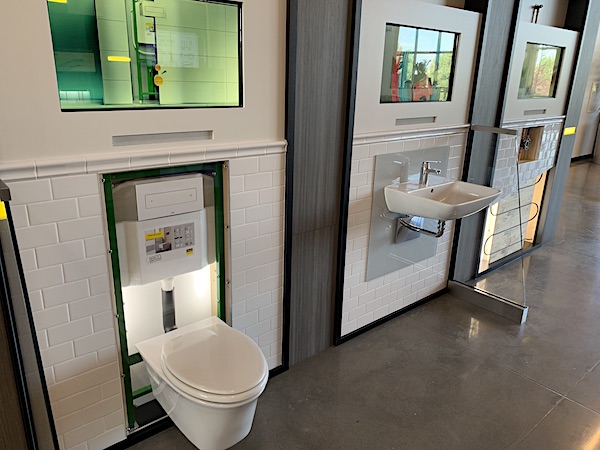
The interactive display at the Broomfield Seminar Center features a breadth of innovative Viega products.

Forced air is still the traditional method of heating homes, but radiant heat is gaining significant momentum as an alternative. According to HGTV, the growth rate of in-floor radiant heating systems was estimated at 30 to 50 percent per year. At the heart of this shift is not just one single benefit. It’s a variety of advantages Read more
Forced air is still the traditional method of heating homes, but radiant heat is gaining significant momentum as an alternative. According to HGTV, the growth rate of in-floor radiant heating systems was estimated at 30 to 50 percent per year.
At the heart of this shift is not just one single benefit. It’s a variety of advantages that radiant floor heating systems bring to the table, the combination of which enhance the daily lives of a home’s occupants:
Even Heat Distribution
When a house is heated by a forced-air system, it will always be warmest near the vents that distribute the air. This can lead to “hotspots” on one end of a room while the other side of the room remains cool. And because hot air rises, upstairs rooms will be warmer than those downstairs.
With radiant floor heating systems, homeowners control how heat circulates in their home. Rather than heating the surrounding air, the heat that radiates from the floor warms other objects in the room and is evenly distributed without the potential for heat loss.
Improved Air Quality
While air pollution is more often associated with the outdoors, indoor air can be dirty as well. Whether it’s dust, pet dander or chemicals from fragrances (among other sources) that pollute the air, forced-air systems exacerbate the problem for allergy sufferers. That’s because the forced, heated air will stir up and mix with these airborne particles.
Since radiant floor heating systems don’t move air to deliver heat, the circulation of indoor particles is minimized. With less pollutants blown around, indoor air quality improves, which benefits allergy sufferers.
No Ductwork
The ductwork in forced-air systems further contributes to air pollution. When it’s riddled with cracks and holes, more dust and odors can enter and circulate. Without proper insulation, these same cracks and holes can cause air to leak out of the system and hinder its overall efficiency.
With no ducts, radiant floor heating systems reduce the churn of dust and allergens while curtailing heat loss. The absence of ducts means less work for homeowners as it eliminates the need for repairs like cleaning out ducts clogged with particles or adding insulation when heat loss mounts.
Energy Savings
With their uneven distribution of heat and potential for heat loss, traditional heating systems can be energy hogs.
Depending on how well a house is insulated, radiant floor systems can save up to 30 percent compared to forced-air systems. In terms of bills, the impact is quite significant as space heating is the largest energy expense for the average U.S. home, accounting for around 45 percent of energy bills.
Noiseless Operation
Homes should be quiet, but forced-air systems can be noisy as furnaces cycle on and off, gaps in the ductwork whistle and loose parts rattle.
By comparison, radiant floor heating systems are exceptionally quiet.
As consumers learn more about the advantages of radiant heating, its popularity will continue to grow.
 Josh Quint is product manager, heating and cooling, for Viega LLC.
Josh Quint is product manager, heating and cooling, for Viega LLC.

Industry veteran Terry Samona has been named Vice President of Human Resources at Viega LLC. Terry oversees human resources management and development at Viega’s operations in the U.S., including headquarters and a seminar center in Broomfield, Colo.; a manufacturing plant and distribution hub in McPherson, Kan.; three additional distribution centers in Nevada, Georgia and Pennsylvania Read more
 Industry veteran Terry Samona has been named Vice President of Human Resources at Viega LLC.
Industry veteran Terry Samona has been named Vice President of Human Resources at Viega LLC.
Terry oversees human resources management and development at Viega’s operations in the U.S., including headquarters and a seminar center in Broomfield, Colo.; a manufacturing plant and distribution hub in McPherson, Kan.; three additional distribution centers in Nevada, Georgia and Pennsylvania; and a seminar center in Nashua, N.H.
“Terry’s skill and experience make him the right person to ensure we continue to hire and develop the best people,” said CEO Dave Garlow. “Viega owes its growth and industry-leading status to its exceptional employees and we know Terry can help us improve our processes and policies even further.”
“I very much look forward to partnering with the executive team and our colleagues to develop an aligned HR strategy,” Samona said. “We want to enable growth while maintaining an environment where a strong culture of striving for excellence and living our Viega Values continues to offer us a competitive advantage in the markets that we serve.”
Samona’s entire career has been in human resources. Prior to joining Viega, he was vice president of human resources at Hach Environmental. He previously held leadership positions at Honeywell International and Entergy Corp.
He has a master’s degree in psychology from Mississippi State University and a bachelor’s degree in psychology from Louisiana State University.
For more information on Viega, click here.
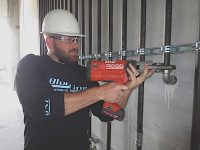
One of the things that keeps contractors up at night is worrying about where their next qualified hire is going to come from. The shortage of skilled workers in the trades is severe and getting worse. Seventy percent of construction companies nationwide are having trouble finding qualified workers, according to the Associated General Contractors of Read more
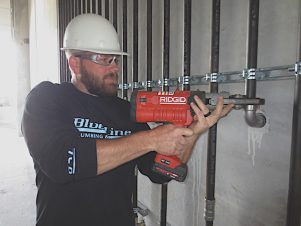 One of the things that keeps contractors up at night is worrying about where their next qualified hire is going to come from.
One of the things that keeps contractors up at night is worrying about where their next qualified hire is going to come from.
The shortage of skilled workers in the trades is severe and getting worse. Seventy percent of construction companies nationwide are having trouble finding qualified workers, according to the Associated General Contractors of America.
And if Congress ever does approve a much-needed infrastructure package, the need will be even greater.
We in the trades can hope parents will stop pushing the necessity of a four-year degree to every child, regardless of interest or qualifications, but there are more practical measures we can take in the meantime.
Last year, Viega LLC launched the Viega Trades Education Network (VTEN) to boost the ranks and skills of students studying the design, installation and function of plumbing and hydronic systems. Viega is partnering with trade schools, community colleges and the UA in the United States and Canada to subsidize and provide training on mechanical systems.
VTEN is about providing a better education for those already enrolled and supporting the schools and instructors that are training the next generation of workers. Like all educational institutions, these schools don’t have the budgets and resources to deliver everything they’d like to give their students.
As members of VTEN, schools get comprehensive curriculum modules that easily integrate into existing programs. The modules include Hydronics 101, Piping & Controls, Radiant Design, Trades Math, Blueprint Reading, CAD and BIM, and more. In addition, Viega provides functional demonstration units supported by lesson plans and projects and a complete tooling package.
Educators receive admission to an annual VTEN conference in Colorado or New Hampshire, including hotel, airfare, food and admission; Viega and direct vendor support of BlueVolt® eLearning platform; hands-on tool demonstrations and LoopCAD® license options and instructor training.
The LoopCAD package includes on-site orientation to the network and a Zoning Demonstration Board and Mixing Demonstration Board to give students hands-on experience in troubleshooting systems.
And, of course, VTEN offers credentialed classes for Viega products, including ProPress® and MegaPress®.
But the program doesn’t stop there. Schools also receive a RIDGID® RP-340 tool or Milwaukee M18® Force Logic Press Tool with a set of jaws for metal and PEX, as well as samples of various types of pipe and couplings for each student.
The first students in VTEN will graduate soon and we welcome them to the ranks of the trades. We invite other companies to follow suit and join us in building the workforce of the future.
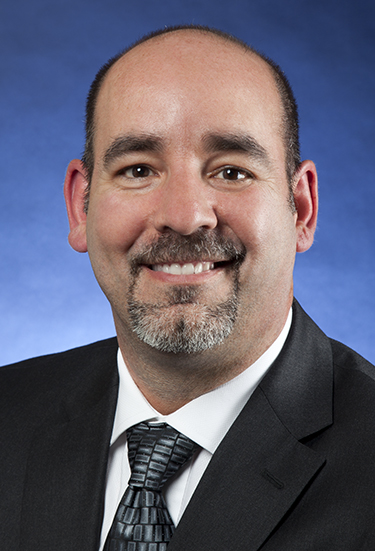 Lino Santoro is Viega Trades Education Network (VTEN) Manager.
Lino Santoro is Viega Trades Education Network (VTEN) Manager.
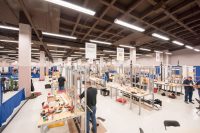
The Plumbing-Heating-Cooling Contractors — National Association’s (PHCC) Educational Foundation is proud to announce the winners of HVAC Apprentice Contest Winners the national plumbing and HVAC apprentice contests. The contests were held October 10th & 11th in Albuquerque, N.M. on the tradeshow floor during the PHCC—National Association’s CONNECT 2018 event. A total of nineteen plumbing and ten HVAC apprentices from across Read more
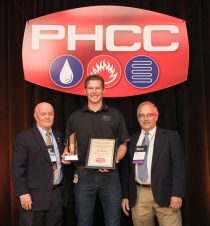
HVAC Contest Winner Josiah Tiegs with PHCC Educational Foundation Chair Craig Lewis and HVAC Contest Committee Chair Scott Balmer.
The Plumbing-Heating-Cooling Contractors — National Association’s (PHCC) Educational Foundation is proud to announce the winners of HVAC Apprentice Contest Winners the national plumbing and HVAC apprentice contests.
The contests were held October 10th & 11th in Albuquerque, N.M. on the tradeshow floor during the PHCC—National Association’s CONNECT 2018 event. A total of nineteen plumbing and ten HVAC apprentices from across the nation took part in the contests.
HVAC Apprentice Contest Winners
- 1st Place: Josiah Tiegs, McDowall Comfort Management in Waite Park, Minn., Sponsored by Brasscraft Manufacturing
- 2nd: Daniel Deneve, GSM Services in Gastonia, N.C., Sponsored by NIBCO
- 3rd: Jeffrey Deuel, American Mechanical Services in Denver, Colo., Sponsored by Milwaukee Tool
Plumbing Apprentice Contest Winners
- 1st Place: James Houser, Local 27 in Pittsburgh, Pa., Sponsored by A. O. Smith
- 2nd: Kyle Mao, Lange Plumbing in Las Vegas, Nev., sponsored by AB&I Foundry
- 3rd: Steven Kroope, Deluxe Plumbing & Heating in Bethlehem, Pa., Sponsored by Reed Manufacturing
The HVAC competitors were required to complete a written test, demonstrate proper brazing techniques and perform a hands-on diagnostic on an HVAC package unit, with system errors created by the Foundation’s contractor volunteers for the competition. The competitors also had to perform a pressure and leak test, demonstrate proper refrigerant recovery procedures and the ability to accurately take a variety of instrument readings.

Plumbing Contest Winner James Houser with PHCC Educational Foundation Chair Craig Lewis and Plumbing Contest Committee Chair Jim Steinle.
The plumbing apprentices were required rough-in a bathroom system. The set-up includes a toilet, sink and shower, complete with supply, waste and vent lines, plus cleanouts and extra features designed to test the contestants’ knowledge and skills. The test set-up includes a variety of pipe materials – cast iron, copper, PVC and PEX, and corresponding joining methods.contractor volunteers for the competition.
A dedicated team of contractor volunteers arrived two days before the competitions to assemble the competitor test benches, distribute the materials and supplies and setup the testing areas. They monitor the competitions, evaluate the apprentices’ work and provide constructive feedback on each competitor’s performance following the event.
The contests are made possible by the generous support of several industry sponsors who provide monetary support and in-kind material and tool donations. Sponsors for the 2018 competition included, AB&I Foundry; A. O. Smith; Bradford White Corp.; BrassCraft Manufacturing Co.; Copper Development Association, Inc.; Daikin; Delta Faucet Co.; Emerson; Fluke, Greene and Associates; IPS Corporation; KOHLER Company; Mechanical Hub Media; Milwaukee Tool; NATE; NIBCO INC.; Oatey; R.E.C. Industries; Reed Manufacturing Co.; RIDGID; State Water Heaters; Tyler Pipe & Coupling; Uponor; Viega, LLC; and Zoeller Pump Company.
Milwaukee Tool made a major contribution to the Plumbing Apprentice Contest this year by donating twenty of their M18 Force Logic Press Tools and jaw kits, with a retail value exceeding $60,000 total. This gift allowed the competitors to gain experience and prove their skill with making press connections during the plumbing competition and will be used in future competitions as well.

Fourth year apprentice, Chris Pinette with E.H. Marchant Co., a union contractor through the local 12, based out of Quincy, Mass. was sponsored by Mechanical Hub Media.
“These contests are an incredible demonstration of the opportunities that exist because of the Foundation,” reports Foundation Chair Craig Lewis. “You have these amazing apprentices from all over the country coming here to show off their skills. The sponsors are so generous with their support. And then our volunteer committee members and staff are pulling it all together in a new exhibit hall every year. It really is quite a thing to see and I’m very proud everyone involved with these competitions.”
